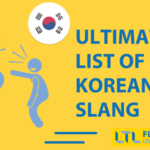Korean Words in English // New Words in The Oxford English Dictionary (for 2022)
26 New Entries Into The Oxford English Dictionary from Korea (in 2022)
DID YOU KNOW Korean words in English is becoming a thing! A big thing in fact.

It was revealed in late 2021 that 26 Korean words have been added to Oxford English Dictionary.
But why?
The answer is quite simple. Heard of BTS, Squid Game, Parasite or Son Heung Min? Chances are you answered yes, and you wouldn’t be the only one.
Korea is taking the UK by storm. Not just the UK in fact. Korea’s influence is becoming a worldwide one.
So much so that the Oxford English Dictionary have taken matters into their own hands and added 26 Korean words to the dictionary.
Today, we teach you these Korean words in English and their meanings.
New Korean Words in English | The List of 26
New Korean Words in English | Their Meanings
New Korean Words in English | FAQ’s

New Korean Words in English | The List of 26
Here is the full list of new Korean words that you’ll now find in the Oxford English Dictionary:
- Aegyo
- Banchan
- Bulgogi
- Chimaek
- Daebak
- Dongchimi
- Fighting
- Galbi
- Hallyu
- Hanbok
- Hangul
- Japchae
- K-drama
- Kimbap
- Kono
- Manhwa
- Mukbang
- Noona
- Oppa
- PC bang
- Samgyeopsal
- Sijo
- Skinship
- Taekwondo
- Tang Soo Do
- Unni

Korean Slang // 25 Super Slang Terms You Must Learn (for 2025)
Ready to learn the most up to date Korean slang being used? This is the Korean slang that you will hear on the street or whilst watching K-Dramas and Movies
New Korean Words in English | The List of 26
Some of those words you’ll know, some you won’t. So now let’s give yo a brief insight into the meaning of each word.
SPOILER – a vast portion of these new words are food related 🤩
Aegyo 애교
애교 refers to a cute display of affection typically expressed through a cute voice, facial expression or some form of gesture.

The literal meaning is along the lines of behaving in a flirty manner!
Alternatively, 애교 can also display closeness with others, which can possibly bring people together.
If you are after a rough translation in English, it’d be something like cuteness, but it almost falls into the category of untranslatable.
BONUS – In China, this can be referred to as sā jiāo 撒娇.
Banchan 반찬
Straight onto the food we go!
반찬 is quite simply a small side dish of vegetables, served along with rice as part of a typical Korean meal.
Bansang can also be used as well.
DID YOU KNOW | As Korean does not distinguish between singular and plural grammatically, the word is used for both one dish or all of them combined.
Bulgogi 불고기
Oh if you’ve never had bulgogi, where have you been!!
In Korean cooking, 불고기 is a dish of thin slices of beef or pork which are marinated then grilled or stir-fried.
Literally, 불고기 means fire meat! 🔥
Chimaek 치맥

What a glorious concept 치맥 is.
Hands up if you like chicken and beer? Thought so!
Shame we never invented a word for both of those in English?
Fear not, Korean is one step ahead and it’s now found in the English Dictionary!
치킨 (chicken) + 맥주 (beer) = 치맥
치맥 can be found in South Korea and Korean-style restaurants and is simply fried chicken served with beer.
Daebak 대박
Moving away from food briefly and into the crazy world of K-Dramas!
Many famous stars in K-Dramas and shows use 대박 frequently.
It describes when something is awesome or it’s a way of showing enthusiasm. It can also describe hitting a windfall or a jackpot.
Either way, it’s a good word!

35 Korean Dramas on Netflix for Newcomers
We made a list of 30+ Korean dramas on Netflix to watch in 2021, so if you’re just starting your Kdrama adventure, you’ll know where to start.
Dongchimi 동치미
Back to food we go!
동치미 is an absolutely delicious type of kimchi made with radish and typically also containing napa cabbage, spring onions, green chilli, and pear.
동치미 is traditionally eaten during the winter in Korea.
Fighting 파이팅
A curious example here because the word is actually in English.
파이팅 is read as paiting, but you’ll also see it written as 화이팅 hwaiting.
Read it slowly, sound familiar?
“Fighting” is a word that’s recently become widely used in Asia to express “Come on” or “Let’s do this”.
In China 加油 (which literally means add oil) is used, and means the same thing.
A team may belt this out before a big match, or someone might tell you 파이팅 or 加油 before an exam.
TOP TIP | Look out for banners of these words at sporting events if watching a Korean or Chinese team! We wouldn’t be surprised if you spotted a few.
In English, of course, fighting, means to physically engage in a fight… now though, there’s an alternate meaning.

63 Korean Words You Never Knew You Knew!
Did you know you already know loads of Korean words and that’s thanks to the inclusion of Korean Loanwords in the language. Here’s our favourites.
Galbi 갈비
Of course, it’s another food related word!
갈비 is a dish made of beef short ribs which are usually marinated in soy sauce, garlic, and sugar
갈비 is generally cooked on a grill at the table.
Hallyu 한류
한류 refers to the growth in popularity of Korea over the last couple decades.
Driven by the likes of K-Pop and Dramas, 한류 literally means The Korean Wave.

An interesting side-note for lovers of multiple languages, the Hanja (a traditional writing system consisting mainly of Chinese characters) for Hallyu is 韩流.
If you are a student of Mandarin you’ll probably recognised these characters as Korea and Popular!
Makes sense now?!
Aside from Music and Dramas, Korea is of course well known worldwide now for its film production (remember Parasite), fashion, and food.
Hanbok 한복
Speaking of fashion…!
The 한복 is one of Korea’s most famous and traditional items of clothing.
Hanbok, oddly enough, literally translates to Korean Clothing.
The history of the 한복 is deep, but nowadays Koreans wear the 한복 for formal or semi-formal occasions and events which can include festivals, celebrations, and ceremonies.
The 한복 consists of a long-sleeved jacket or blouse and a long, high-waisted skirt for women or loose-fitting trousers for men.
You can rent Hanbok in shops around any temple you visit in Seoul!
Hangul 한글

한글 is name of the Korean alphabet!
According to King Sejong The Great, who was the inventor of Hangul…
“A wise man [could] acquaint himself with them before the morning [was] over; a stupid man [could] learn them in the space of ten days.”
Hangul, also written Hangeul, used to be composed of 28 basic letters, but over the passage of time 4 letters were lost.
Therefore, today only 24 of these remain in Hangul, the Korean Alphabet. 14 consonant letters and 10 vowels.

The Korean Alphabet | A Complete and Definitive Guide to Hangul 한글
Learning Korean? Need to understand the Korean Alphabet? This complete guide will tell you everything about the 14 consonant letters and 10 vowels of Hangul
Japchae 잡채
Annnd back to the food we go!
잡채 is a famous Korean dish consisting of cellophane noodles made from sweet potato starch, stir-fried with vegetables and other ingredients, and typically seasoned with soy sauce and sesame oil.
A must try Korean dish!
K-Drama
Of all the Korean words in English, this doesn’t really need any introduction does it?!
Especially after the success of everyone’s new favourite drama – Squid Game.
Anyway, for those of you still unsure, K-Drama is simply short for Korean Drama, and can now be found as a word in the Oxford English Dictionary!
Crazy, right!?

29 of the Best Korean Dramas to Binge Watch This Weekend
Don’t limit yourself to apps and books! Watching TV is also an efficient way to learn! Here is our selection of some of the best Korean dramas to study.
Kimbap 김밥
김밥 (kimbap or gimbap) is a Korean dish consisting of cooked rice and other ingredients wrapped in a sheet of seaweed and cut into bite-sized slices.
김밥 is a popular take-out food in South Korea and abroad. It’s known as a convenient food because it’s very easy to carry around, just like your old packed lunch!
Gonu 고누

고누 (spoken as gonu or kono) are a group of traditional Korean board games.
The games are mainly used for kids during education, but are well-known throughout Korea.
고누 are games of strategy played using marbles or other pieces which are placed and moved on rows of small holes or lines on the ground or on a board.
Manhwa 만화

Sound familiar to another Asian word you might know?
Take a look again, and read it out to yourself a few times.
Got it yet?
만화 are in fact a Korean genre of cartoons and comic books, often influenced by Japanese manga.
Manga, manhwa – not too dissimilar are they!
Mukbang 먹방

먹방, which can also be read as meokbang, is an online eating show!
Yes, you read that correctly!
These started to gain popularity in Korea in 2010, and then started to explode onto the worldwide scene.
먹방 typically involves someone eating a fair quantity of food, on a livestream, whilst interacting with users online.
Noona 누나
A family related term here.
A 누나 is a male’s elder sister. 누나 is also a respectful way to address someone or a term of endearment and is used by males with reference to an older female friend.
It’s worth noting in English “older sister” is used from the perspective or either male or female but in Korean that is not the case, they are gender specific.
Oppa 오빠
And following on nicely from 누나 we have 오빠.
Any guesses?
오빠 is indeed a female’s elder brother.
오빠 is also used to address an older male friend, even if he is not your older brother by blood.
PC Bang PC방
Like Fighting, this sounds like an English example, but not quite.
방 actually means room, not bang!
In South Korea, a PC방 is an establishment with multiple computer terminals providing access to the internet for a fee, usually for gaming.
How much would one spend normally I hear you ask? Not much actually.
The typical cost for an hour of play at a PC방 can range from 500 to 1500 Korean Won. This is roughly just half a US dollar (to just over 1 USD).
1,000 KRW per hour is the most common rate of a Korean PC방.
Samgyeopsal 삼겹살
삼 in Korean means 3, so it would come as no surprise to learn that 삼겹살 means a 3 layer meat in Korean.
In a nutshell 삼겹살 is a Korean dish of thinly sliced pork belly, usually served raw, and to be cooked by the diner on a tabletop grill.
The 3 layer doesn’t refer to 3 layers of meat stacked on one another, but actually referring to striations of lean meat and fat in the pork belly that appear as three layers when cut.
Sijo 시조
시조 is a type of Korean classical vocal music, often also featuring percussion, and typically characterised by a slow tempo.
To discover more about 시조, check out Wikipedia’s in-depth look at the poems and their history.
Skinship 스킨십
When read, this sounds very similar to the English – seukinsip. But what on earth does that mean?
It in fact refers to close physical contact between lovers or friends, used to express affection or strengthen an emotional bond.
It can also refer to the strength of a bond in family too, particularly a mother and a child
Taekwondo 태권도

In anything, the big surprise here is that this word wasn’t in the English disctionary before.
This is probably the word out of all these listed, that an English speaker would be most familiar with.
We all of course know that 태권도 is a famed form of Martial Arts.
What you maybe didn’t know, was that it originated in Korea, and not Japan like a number of others assume.
Taekwondo’s popularity worldwide should not be underestimated especially given the fact it is now a firmly established Olympic sport.
Tang Soo Do 당수도
Staying on that theme here with 당수도.
당수도 is a Korean martial art using the hands and feet to deliver and block blows.
It is very similar to Japanese Karate.
Unni 언니
We finish our listed of new Korean words in English with another family related term.
언니 refers to a female’s older sister. However, once again, a female could refer to an older female friend as her 언니 also.
THere are you 26 new Korean words in English. All now proudly taking up their own segment in the Oxford English Dictionary – who’d have thought that 20 years ago!
Korea is stamping down it’s authority on the world in so many ways!
Surely more words will follow, but which ones? Leave a comment below with your favourites and thanks for reading!
New Korean Words in English // FAQ’s
What is Hangul?
한글, simply put, is the Korean alphabet!
According to King Sejong The Great, who was the inventor of Hangul…
“A wise man [could] acquaint himself with them before the morning [was] over; a stupid man [could] learn them in the space of ten days.”
Hangul used to be composed of 28 basic letters, but over the passage of time 4 letters were lost.
Therefore, today only 24 of these remain in Hangul, the Korean Alphabet. 14 consonant letters and 10 vowels.
What is Japchae?
잡채 is a famous Korean dish consisting of cellophane noodles made from sweet potato starch, stir-fried with vegetables and other ingredients, and typically seasoned with soy sauce and sesame oil.
A must try Korean dish!
What is the meaning of Daebak?
Many famous stars in K-Dramas and shows use 대박 frequently.
It describes when something is awesome or it’s a way of showing enthusiasm. It can also describe hitting a windfall or a jackpot.
Either way, it’s a good word!
What is the concept of Chimaek?
Hands up if you like chicken and beer? Thought so!
Shame we never invented a word for both of those in English?
Fear not, Korean is one step ahead and it’s now found in the English Dictionary!
치맥 can be found in South Korea and Korean-style restaurants and is simply fried chicken served with beer.
What is 파이팅?
파이팅 is read as paiting or hwaiting.
Read it slowly, sound familiar?
“Fighting” is a word that’s recently become widely used in Asia to express “Come on” or “Let’s do this”.
In China 加油 (which literally means add oil) is used, and means the same thing.
A team may belt this out before a big match, or someone might tell you 파이팅 or 加油 before an exam.
TOP TIP | Look out for banners of these words at sporting events if watching a Korean or Chinese team! We wouldn’t be surprised if you spotted a few.
What is 애교?
애교 refers to a cute display of affection typically expressed through a cute voice, facial expression or some form of gesture.
The literal meaning is along the lines of behaving in a flirty manner!
Alternatively, 애교 can also display closeness with others, which can possibly bring people together.
If you are after a rough translation in English, it’d be something like cuteness, but it almost falls into the category of untranslatable.
Is an 오빠 used just for blood relatives?
오빠 is also used by women to address an older male friend, even if he is not your older brother by blood.
So the answer is no, 오빠 can be used for friends as well as family.
What is a Noona 누나?
A 누나 is a male’s elder sister.
누나 is also a respectful way to address someone or a term of endearment and is used with reference to an older female friend.
It’s worth noting in English “older sister” is used from the perspective or either male or female but in Korean that is not the case, they are gender specific.
Want More From LTL?
FANCY LEARNING KOREAN? Check out our online Korean courses here.
We offer a 7-day free trial to all online students where you can study Korean 24/7.
Want to study Korean in Korea instead? Our Korean courses in Seoul can either be taken in small groups of no more than 5 students or individually for a more tailored experience.
We even offer incredible homestay experiences in Seoul too.
To top it all off, it certainly doesn’t end with Korean. Check out the other languages we teach 👇🏻










2 comments
I cannot believe so many made it to the English dictionary! Korean FTW!
And it's only growing!